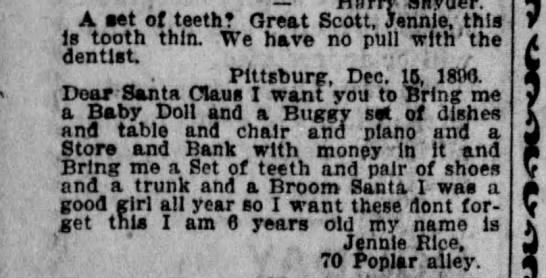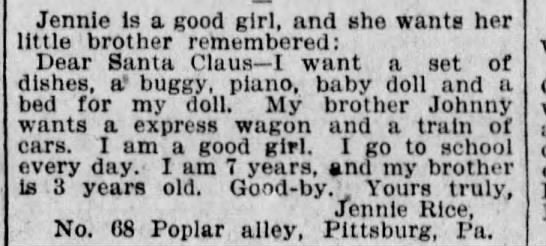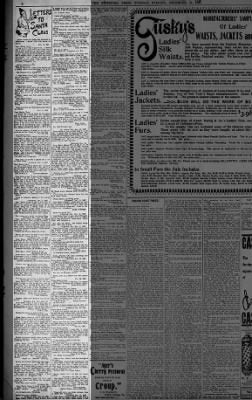One of the sweetest moments in my family tree exploration was the discovery of a very simple item - a letter to Santa published in the Pittsburgh Press on 18 December 1896. The author was a 6-year-old girl named Jennie Rice. She lived at 70 Poplar Alley in the Lower Hill District, an inner city neighborhood that was razed to make way for the Civic Arena and now the PPG Paints Arena.

Pittsburgh Press
Jennie was either my great-grandmother whom we knew as Jane or another sister that we’ve never know about. We’ve lost track of this family unit from 1890-1910 while the children were young so it is difficult to know for certain. Jane was born in 1893 which is not the right age for this letter. But the letter is a lovely little gift, a glimpse into daily life of this family unit.
Jennie has an interesting array of present preferences, including a bank filled with money and a set of teeth. As I began researching “Dear Santa” features in historical papers, I discovered that teeth were not an infrequent request. One young boy asked for teeth for his 3 month old brother so the baby could eat good food. Generous of him.
Interestingly, the Smithsonian explains that the very first letters were from Santa, admonishing children about their behavior. Think of that cozy first Christmas in ‘Little Women’ where Marmee urges her girls to fix their flaws because soon the evil cruelty of time will kill their sister and make the time of getting a book like ‘Pilgrims Progress’ and an orange for Christmas seem idyllic
Dear Santa letters began to catch on in the mid-1800′s as children addressed the practical need to inform Santa of their wishes and their whereabouts when they moved. This coincided with the expansion of the U.S. Postal Service to offer home delivery rather than requiring people to pick up their mail. Publishing this endearing (and humorous) content in newspapers was a seemingly calculated move to ‘curate’ content and document the new holiday tradition. The first known letter to Santa was published on December 24, 1874 in the Stark County Democrat, a paper in Dayton, Ohio.
Eventually, the tradition grew so overwhelming that the Postal Service teamed up with charitable organizations to stamp out the practice of destroying letter and start writing back. And that’s what saved Kris Kringle from prosecution in the movie ‘Miracle on 34th Street.’
My Jennie has another letter published in 1897

Pittsburgh Press, December 1897
Jennie got a little wiser, throwing in her brother for good measure. You might notice that her address has changed from No. 70 to No. 68.
Details in these letters were very helpful to me. I've found other references to this and nearby addresses in the family. There was a John Rice born in 1894, Jennie's brother Johnny likely. Her older sister Margaret would have been 10 and perhaps too old for Santa Claus by then. Jennie's maternal grandfather, Patrick Rice, lived at 68 Poplar. Why didn't Jennie mention sister Jane? Is it perhaps because they were not living together - some of the children were living with cousins and aunts? Or were Jennie and Jane the same person?
Letters were apparently a family tradition. Jennie's cousin Mary Campbell also penned a request in 1897. Her family lived on nearby Basin Alley, another street in the Lower Hill District. Mary's father, Daniel, was a fire captain who would tragically die in a 1900 blaze. He and his wife experienced several fires themselves while living in Basin Alley. They had 8 children, five of whom did not survive to adulthood. Several were named Mary (in the good old Irish way) so it isn't exactly clear which child wrote what letter.
What resonates with me all these years later is that the children were still children with their hopes and wishes and demands. And that there must have been some adult in their lives who cared enough to transcribe their wishes and send the to the newspaper. That tempers some of my sadness about wondering what their lives were like.
I wonder if Jennie ever got those teeth?
This post is part of a blog series on my 2x great grandmothers. Other posts in this series:
- My Family Story: The Long Life of Regina Gallagher (1864-1960)
- My Family Story: The Mysterious Life of Sarah Ann Campbell (1871-1907)
- My Family Story: The Unknown Legacy of Anna Gottheld (1874-1949)
- My Family Immigration Story: The Short Life of Sadie Butler (1872-1922)
- My Family Immigration Story: The Tragic Life of Jennie Tarleton (1868-1944)
